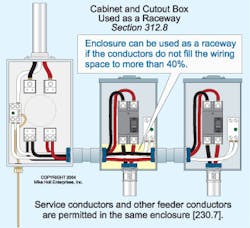All questions and answers are based on the 2005 NEC.
Q. Can I pass conductors from one panel through another panel? If so, what are the restrictions?
A. Yes, cabinets, cutout boxes, and meter socket enclosures can be used as a raceway for conductors that feed through if the conductors do not fill the wiring space at any cross section to more than 40% [312.8], as shown in the Figure.
Service conductors and other conductors are permitted to be installed in the same enclosure [230.7]. Splices and taps can be installed in cabinets, cutout boxes, or meter socket enclosures if the splices or taps do not fill the wiring space at any cross section to more than 75% [312.8].
Q. What are the rules for installing fluorescent luminaires in clothes closets?
A. There are specific clearances that must be maintained for either fluorescent or incandescent luminaires installed in a clothes closet. Here are the rules from 410.8(D):
-
Surface-mounted, totally enclosed, incandescent luminaires must maintain a minimum clearance of 12 inches from the storage space.
-
Surface-mounted fluorescent luminaires must maintain a minimum clearance of 6 inches from the storage space.
-
Recessed incandescent luminaires with a completely enclosed lamp must maintain a minimum clearance of 6 inches from the storage space.
-
Recessed fluorescent luminaires must maintain a minimum clearance of 6 inches from the storage space.
Q. What are the disconnecting means requirements for transformers?
A. The NEC does not have specific requirements for disconnecting means at a transformer; however, you must follow the overcurrent protection requirements of Art. 450 and Art. 240.
Q. In what rooms of a home is an electrical panel with breakers prohibited?
A. Overcurrent protection devices should not be located where they would be subjected to physical damage or in areas where they might create a fire or safety hazard [240.24(C)]. Some specific locations are prohibited in dwelling units. They include:
-
Near easily ignitible material, such as in clothes closets [240.24(D)]. The purpose of keeping overcurrent protection devices away from easily ignitible material is to prevent fires — not to keep them out of clothes closets.
-
In the bathrooms of dwelling units, or guest rooms or guest suites of hotels or motels [240.24(E)]. The service disconnecting means must not be located in a bathroom, even in commercial or industrial facilities [230.70(A)(2)].
Q. Can Type NM cable in a dwelling unit be used to wire recessed light fixtures that require the circuit conductors to have at least a 90°C rating?
A. Yes, Type NM conductors are rated at 90°C [334.104], even though the ampacity is required to be selected based on the 60°C column of Table 310.16 [334.80].
Q. I have noticed that some light fixtures located in the attics and crawl spaces of numerous residences have been damaged unintentionally. Does the NEC require fixtures in these locations to be suitably guarded against accidental damage?
A. Nothing in the NEC requires guarding of light fixtures in the attics of dwelling units. When installed around combustible material, luminaires are required to have guards to limit the temperature around the combustible material [410.5].
Q. A 30kVA, 480V/208V transformer is fed by a 60A, 3-pole breaker from a 480V panel. This transformer secondary then feeds a 120V/208V panel, which is located within 10 feet of conductor length. Is secondary overcurrent protection required for the secondary conductors?
A. The NEC permits 10 feet of secondary conductors without secondary conductor protection if [240.21(C)(2)]:
-
The ampacity of the secondary conductor must not be less than:
a. The calculated load in accordance with Art. 220,
b. The rating of the device supplied by the secondary conductors or the overcurrent protective device at the termination of the secondary conductors, and
c. Not less than one-tenth the rating of the overcurrent device protecting the primary of the transformer multiplied by the primary-to-secondary transformer voltage ratio.
-
The secondary conductors must not extend beyond the switchboard, panelboard, disconnecting means, or control devices they supply.
-
The secondary conductors must be enclosed in a raceway. Secondary overcurrent protection is not required for the secondary conductors, but overcurrent protection is required for lighting and appliance branch-circuit panelboards. This protection is required to be located on the secondary side of the transformer [408.36(D)].
About the Author

Mike Holt
Mike Holt is the owner of Mike Holt Enterprises (www.MikeHolt.com), one of the largest electrical publishers in the United States. He earned a master's degree in the Business Administration Program (MBA) from the University of Miami. He earned his reputation as a National Electrical Code (NEC) expert by working his way up through the electrical trade. Formally a construction editor for two different trade publications, Mike started his career as an apprentice electrician and eventually became a master electrician, an electrical inspector, a contractor, and an educator. Mike has taught more than 1,000 classes on 30 different electrical-related subjects — ranging from alarm installations to exam preparation and voltage drop calculations. He continues to produce seminars, videos, books, and online training for the trade as well as contribute monthly Code content to EC&M magazine.
